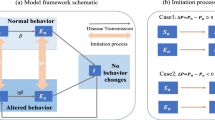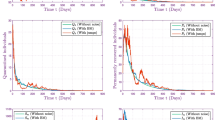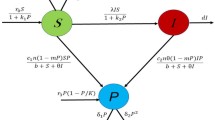Abstract
We study an open population stochastic epidemic model from the time of introduction of the disease, through a possible outbreak and to extinction. The model describes an SIS (susceptible–infective–susceptible) epidemic where all individuals, including infectious ones, reproduce at a given rate. An approximate expression for the outbreak probability is derived using a coupling argument. Further, we analyse the behaviour of the model close to quasi-stationarity, and the time to disease extinction, with the aid of a diffusion approximation. In this situation the number of susceptibles and infectives behaves as an Ornstein–Uhlenbeck process, centred around the stationary point, for an exponentially distributed time before going extinct.
Similar content being viewed by others
References
Anderson RM, May RM (1991) Infectious diseases of humans: dynamics and control. Oxford University Press, Oxford
Andersson H, Britton T (2000) Stochastic epidemic models and their statistical analysis. Springer, New York
Andersson H, Djehiche B (1998) A threshold limit theorem for the stochastic logistic epidemic. J Appl Probab 35(3): 662–670
Bailey NTJ (1975) The mathematical theory of infectious diseases and its applications, 2nd edn. Griffin, London
Clancy D, O’Neill PD, Pollett PK (2001) Approximations for the long-term behavior of an open-population epidemic model. Methodol Comput Appl Probab 3(1): 75–95
Karatzas I, Shreve SE (1991) Brownian motion and stochastic calculus. 2nd edn. Springer, Berlin
Kurtz TG (1970) Solutions of ordinary differential equations as limits of pure jump Markov processes. J Appl Probab 7: 49–58
Kurtz TG (1971) Limit theorems for sequences of jump Markov processes approximating ordinary differential processes. J Appl Probab 8: 344–356
Kurtz TG (1981) Approximation of population processes. CBMS-NSF regional conference series in Applied Mathematics, vol 36. Society for Industrial and Applied Mathematics (SIAM), Philadelphia
Nåsell I (1999) On the time to extinction in recurrent epidemics. J R Stat Soc Ser B: Stat Methodol 61(2): 309–330
Nåsell I (2002) Stochastic models of some endemic infections. Math Biosci 179(1): 1–19
O’Neill P (1996) Strong approximations for some open population epidemic models. J Appl Probab 33(2): 448–457
Råde L, Westergren B (1998) Mathematics handbook for science and engineering, 4th edn. Studentlitteratur, Lund
Author information
Authors and Affiliations
Corresponding author
Rights and permissions
About this article
Cite this article
Andersson, P., Lindenstrand, D. A stochastic SIS epidemic with demography: initial stages and time to extinction. J. Math. Biol. 62, 333–348 (2011). https://doi.org/10.1007/s00285-010-0336-x
Received:
Revised:
Published:
Issue Date:
DOI: https://doi.org/10.1007/s00285-010-0336-x
Keywords
- Stochastic epidemic model
- Quasi stationarity
- SIS model
- Coupling
- Ornstein–Uhlenbeck
- Diffusion approximation
- Outbreak probability




